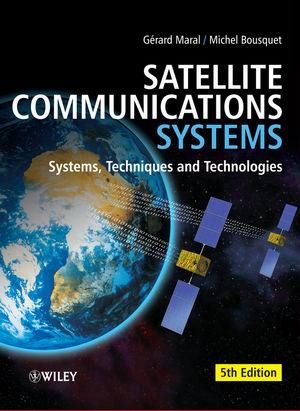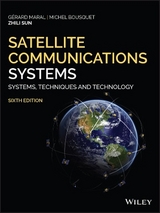
Satellite Communications Systems
John Wiley & Sons Inc (Verlag)
978-0-470-71458-4 (ISBN)
- Titel erscheint in neuer Auflage
- Artikel merken
Revisions to 5th Edition by: Zhili Sun, University of Surrey, UK New and updated edition of this authoritative and comprehensive reference to the field of satellite communications engineering Building on the success of previous editions, Satellite Communications Systems, Fifth Edition covers the entire field of satellite communications engineering from orbital mechanics to satellite design and launch, configuration and installation of earth stations, including the implementation of communications links and the set-up of the satellite network. This book provides a comprehensive treatment of satellite communications systems engineering and discusses the technological applications. It demonstrates how system components interact and details the relationship between the system and its environment. The authors discuss the systems aspects such as techniques enabling equipment and system dimensioning and state of the art technology for satellite platforms, payloads and earth stations.
New features and updates for the fifth edition include: More information on techniques allowing service provision of multimedia content Extra material on techniques for broadcasting, including recent standards DVB-RCS and DVB-S2 (Digital Video Broadcasting -Return Channel Satellite and -Satellite Version 2) Updates on onboard processing By offering a detailed and practical overview, Satellite Communications Systems continues to be an authoritative text for advanced students, engineers and designers throughout the field of satellite communications and engineering.
Gérard Maral was appointed Professor of the University Paul Sabatier in 1970 and joined the Ecole Nationale Supérieure des Télécommunications (ENST) in 1984 as a full-time Professor and subsequently developed the ENST Site at the University of Toulouse and its Satellite Communications Systems Educational and Research Programme. In 2003, he set up the Master of Sciences in Aerospace Communications Systems for ENST on its Toulouse site. He is a well-known international expert and lecturer in satellite communications. Michel Bousquet is Professor at the Ecole Nationale Aeronautique et Espace (SUPAERO), where he manages the graduate and post-graduate programmes in Aerospace Electronics and Communications. He is also Affiliate Professor at ENST, Associate Lecturer at University of Surrey and Faculty member of the International Space University (ISU), and has over 20 years of teaching and research experience. He is a member of the boards of the International Journal of Satellite Communications and Wireless Personal Communications Journal, and session chairman of several international IEEE and AIAA conferences.
ACKNOWLEDGEMENT. ACRONYMS. NOTATION. 1 INTRODUCTION. 1.1 Birth of satellite communications. 1.2 Development of satellite communications. 1.3 Configuration of a satellite communications system. 1.4 Types of orbit. 1.5 Radio regulations. 1.6 Technology trends. 1.7 Services. 1.8 The way forward. References. 2 ORBITS AND RELATED ISSUES. 2.1 Keplerian orbits. 2.2 Useful orbits for satellite communication. 2.3 Perturbations of orbits. 2.4 Conclusion. References. 3 BASEBAND SIGNALS AND QUALITY OF SERVICE. 3.1 Baseband signals. 3.2 Performance objectives. 3.3 Availability objectives. 3.4 Delay. 3.5 Conclusion. References. 4 DIGITAL COMMUNICATIONS TECHNIQUES. 4.1 Baseband formatting. 4.2 Digital modulation. 4.3 Channel coding. 4.4 Channel coding and the power-bandwidth trade-off. 4.5 Coded modulation. 4.6 End-to-end error control. 4.7 Digital video broadcasting via satellite (DVB-S). 4.8 Second generation DVB-S. 4.9 Conclusion. References. 5 UPLINK, DOWNLINK AND OVERALL LINK PERFORMANCE; INTERSATELLITE LINKS. 5.1 Configuration of a link. 5.2 Antenna parameters. 5.3 Radiated power. 5.4 Received signal power. 5.5 Noise power spectral density at the receiver input. 5.6 Individual link performance. 5.7 Influence of the atmosphere. 5.8 Mitigation of atmospheric impairments. 5.9 Overall link performance with transparent satellite. 5.10 Overall link performance with regenerative satellite. 5.11 Link performance with multibeam antenna coverage vs moonbeam coverage. 5.12 Intersatellite link performance. References. 6 MULTIPLE ACCESS. 6.1 Layered data transmission. 6.2 Traffic parameters. 6.3 Traffic routing. 6.4 Access techniques. 6.5 Frequency division multiple access (FDMA). 6.6 Time division multiple access (TDMA). 6.7 Code division multiple access (CDMA). 6.8 Fixed and on-demand assignment. 6.9 Random access. 6.10 Conclusion. References. 7 SATELLITE NETWORKS. 7.1 Network reference models and protocols. 7.2 Reference architecture for satellite networks. 7.3 Basic characteristics of satellite networks. 7.4 Satellite on-board connectivity. 7.5 Connectivity through intersatellite links (ISL). 7.6 Satellite broadcast networks. 7.7 Broadband satellite networks. 7.8 Transmission control protocol. 7.9 IPv6 over satellite networks. 7.10 Conclusion. References. 8 EARTH STATIONS. 8.1 Station organisation. 8.2 Radio-frequency characteristics. 8.3 The antenna subsystem. 8.4 The radio-frequency subsystem. 8.5 Communication subsystems. 8.6 The network interface subsystem. 8.7 Monitoring and control; auxiliary equipment. 8.8 Conclusion. References. 9 THE COMMUNICATION PAYLOAD. 9.1 Mission and characteristics of the payload. 9.2 Transparent repeater. 9.3 Regenerative repeater. 9.4 Multibeam antenna payload. 9.5 Introduction to flexible payloads. 9.6 Solid state equipment technology. 9.7 Antenna coverage. 9.8 Antenna characteristics. 9.9 Conclusion. References. 10 THE PLATFORM. 10.1 Subsystems. 10.2 Attitude control. 10.3 The propulsion subsystem. 10.4 The electric power supply. 10.5 Telemetry, tracking and command (TTC) and on-board data handling (OBDH). 10.6 Thermal control and structure. 10.7 Developments and trends. References. 11 SATELLITE INSTALLATION AND LAUNCH VEHICLES. 11.1 Installation in orbit. 11.2 Launch vehicles. References. 12 THE SPACE ENVIRONMENT. 12.1 Vacuum. 12.2 The mechanical environment. 12.3 Radiation. 12.4 Flux of high energy particles. 12.5 The environment during installation. References. 13 RELIABILITY OF SATELLITE COMMUNICATIONS SYSTEMS. 13.1 Introduction of reliability. 13.2 Satellite system availability. 13.3 Subsystem reliability. 13.4 Component reliability. INDEX.
| Erscheint lt. Verlag | 15.12.2009 |
|---|---|
| Mitarbeit |
Mitglied der Redaktion: Zhili Sun |
| Verlagsort | New York |
| Sprache | englisch |
| Maße | 197 x 258 mm |
| Gewicht | 1556 g |
| Themenwelt | Technik ► Elektrotechnik / Energietechnik |
| Technik ► Nachrichtentechnik | |
| ISBN-10 | 0-470-71458-1 / 0470714581 |
| ISBN-13 | 978-0-470-71458-4 / 9780470714584 |
| Zustand | Neuware |
| Haben Sie eine Frage zum Produkt? |
aus dem Bereich



